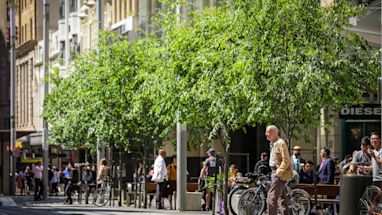When 72 people died in London’s Grenfell Tower fire 2 years ago, it put the spotlight on potentially flammable material being used in thousands of buildings around the world.
Australian governments began urgently assessing buildings with flammable cladding and evaluating the risk.
The City of Sydney responded quickly, creating a team of building professionals led by fire safety specialist Luke Farrell.
This dedicated team investigates buildings on the NSW Department of Planning, Industry and Environment’s cladding register and buildings referred through NSW Fire and Rescue and other sources.
“Grenfell was the watershed for cladding compliance. It wasn’t the first building fire as a result of cladding, but it was the perfect storm,” Luke said.
“There was a lack of fire sprinklers, no secondary emergency fire exit, poor fire resistive construction, inadequate fire management procedures and highly flammable cladding.
“Australian authorities have taken enormous steps to reduce the potential for a similar disaster.”
Luke leads a team of experts investigating 307 buildings with potentially combustible cladding.
“We have the most buildings with potentially flammable cladding out of any local government area in Sydney,” Luke said.
“We’ve prioritised inspections of the potentially high-risk buildings to ensure they’re remedied sooner.
“Our officers go in and look at a building, review any plans we have on file, talk to the building managers about any issues and work on a remediation plan.
“So far we’ve completed investigations on 47 buildings and issued 41 fire safety notices to replace cladding or provide further information on existing materials and finishes.
“We've inspected all high risk buildings and if necessary will issue them with specific action requests as soon as possible. We continue to move through our list of buildings quickly based on descending risk.”
Luke said determining whether cladding was combustible often required a lab test.
“The test will reveal the content of the inner core material, which can be made up of an inert non-flammable material, fire retardant material or highly flammable polyethylene. The more polyethylene content, the more hazardous the material,” Luke said.
With the NSW Government not releasing the list of potentially flammable buildings on security grounds, some have expressed concerns about whether their building is flammable.
“If you’re concerned about your building, speak to your owner’s corporation or building management team about whether a combustible audit has been done and what the results were,” Luke said.
“If an audit hasn’t been done, suggest that one takes place. It will require a qualified expert to determine the type of cladding fitted to your building. It may also be worth asking whether the building’s other fire safety measures are being properly maintained and whether their annual fire safety statement is up to date.
“In the interim, the best steps building occupants can take is limiting any ignition sources and storage objects on their balconies and making sure barbecues are always turned off when not being used.”
If you have any queries or concerns about potentially flammable buildings, contact the City of Sydney on 02 9265 9333.
Published 15 January 2020


